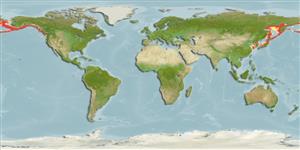Environment: milieu / climate zone / depth range / distribution range
Ökologie
seewasser demersal; tiefenbereich 0 - 761 m (Ref. 50550), usually 50 - 200 m (Ref. 28160). Temperate
North Pacific: Sea of Japan from Korea to Tatar Strait, Sea of Okhotsk from mouth of Amur River to Aniva Bay off Cape Terpeniya, Pacific off Hokkaido to Kuril Islands and southeastern Kamchatka, northern and eastern Bering Sea.
Size / Gewicht / Alter
Maturity: Lm ? range ? - ? cm
Max length : 66.0 cm FL Männchen/unbestimmt; (Ref. 115020)
Kurzbeschreibung
Morphologie | Morphometrie
Rückenflossenstacheln (insgesamt): 0; Rückenflossenweichstrahlen (insgesamt): 43-48; Afterflossenstacheln 0; Afterflossenweichstrahlen: 35 - 39; Wirbelzahl: 48 - 52. Pectoral fin shallowly notched; caudal fin broad, posterior margin rounded, dorsal and ventral notches on caudal fin usually present (Ref. 28160). Body color extremely variable - gray, light brown, brown, spotted, speckled, dusted, striped, mottled, reticulated and plain patterns; dorsal and anal fins with the same color pattern as body or blackish; caudal fin with 2 or 3 broad dark bands, with several irregular dark bars, or entirely blackish (Ref. 28160). Eye silvery, when fresh (Ref. 28160).
Life cycle and mating behavior
Geschlechtsreife | Fortpflanzung | Ablaichen | Eier | Fecundity | Larven
Masuda, H., K. Amaoka, C. Araga, T. Uyeno and T. Yoshino, 1984. The fishes of the Japanese Archipelago. Vol. 1. Tokai University Press, Tokyo, Japan. 437 p. (text). (Ref. 559)
IUCN Rote Liste Status (Ref. 130435)
Bedrohung für Menschen
Harmless
Nutzung durch Menschen
Mehr Information
NamenSynonymeMetabolismusRäuberÖkotoxikologieFortpflanzungGeschlechtsreifeAblaichenSpawning aggregationFecundityEierEientwicklung
ReferenzenAquakulturAquakultur ProfilZuchtlinienGenetikElectrophoresesVererbbarkeitKrankheitenVerarbeitungNutrientsMass conversion
PartnerBilderStamps, Coins Misc.LauteCiguateraGeschwindigkeitSchwimmstilKiemenoberflächeOtolithsGehirngrößeSehfähigkeit
Tools
Zusatzinformationen
Download XML
Internet Quellen
Estimates based on models
Preferred temperature (Ref.
123201): 0.2 - 8.8, mean 3 °C (based on 633 cells).
Phylogenetic diversity index (Ref.
82804): PD
50 = 0.5000 [Uniqueness, from 0.5 = low to 2.0 = high].
Bayesian length-weight: a=0.00676 (0.00374 - 0.01221), b=3.16 (3.00 - 3.32), in cm total length, based on LWR estimates for this species & (Sub)family-body (Ref.
93245).
Trophic level (Ref.
69278): 3.4 ±0.45 se; based on food items.
Widerstandsfähigkeit (Ref.
120179): niedrig, Verdopplung der Population dauert 4,5 - 14 Jahre. (Preliminary K or Fecundity.).
Fishing Vulnerability (Ref.
59153): Moderate to high vulnerability (49 of 100).
